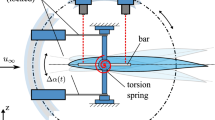Abstract
Boundary layer states, including laminar, turbulent, attached or separated, have significant effects on an airfoil operation and aerodynamic forces; especially as the boundary layer becomes turbulent or separated, the drag forces increase significantly. In the compressible flow and the transonic regime, when the compressibility effects and shock–boundary layer interaction are also considered, the flow field is so complicated that it cannot be easily investigated using the theoretical and computational methods. In this study boundary layer is investigated experimentally in several static angles of attack and also, during sinusoidal pitching motions at M ∞ = 0.65, Reynolds number of 9.202 million per meter, using multiple hot film and pressure sensors. Transition and relaminarization points, supersonic region, and shock formation are detected on the upper surface of the airfoil, and, the reduced frequency effect is investigated in dynamic case. It is worth mentioning that the low-range oscillation amplitudes and reduced frequencies used in this research led to quite different and interesting results that have not been considered in the other investigations dealing with oscillating airfoils.













Similar content being viewed by others
Abbreviations
- c :
-
Airfoil chord
- C P :
-
Pressure coefficient
- F :
-
Oscillation frequency
- k :
-
Reduced frequency, πfc/U ∞
- M ∞ :
-
Free-stream mach number
- MHFS:
-
Multiple hot film sensor
- PSD:
-
Power spectral density
- RMS:
-
Root mean square
- T :
-
Transition point
- R :
-
Relaminarization point
- x/c :
-
Non-dimensional distance from the leading edge
- t :
-
Time
- τ :
-
Time scale, ωt
- U ∞ :
-
Free stream velocity
- AOA:
-
Static angle of attack
- α0 :
-
Mean angle of attack
- αu :
-
Instantaneous angle of attack during pitch up
- αd :
-
Instantaneous angle of attack during pitch down
- αmin :
-
Minimum angle of attack in pitching motion
- αmax :
-
Maximum angle of attack in pitching motion
- α(t):
-
Instantaneous angle of attack, α0 + ∆α sin(ωt)
- ∆α:
-
Oscillation amplitude
- ω :
-
Angular frequency, 2πf
References
Lee T, Gerontakos P (2004) Investigation of flow over an oscillating airfoil. J Fluid Mech 512:313–341
Lee T, Basu S (1998) Measurement of unsteady boundary layer developed on an oscillating airfoil using multiple hot-film sensors. Exp Fluids 25(2):108–117
Meijering A, Schroder W (2001) Experimental analysis of separated transitional transonic airfoil flow. AIAA 2001–2987
Hausmann F, Schroder W (2006) Coated hot-film sensors for transition detection in cruise flight. J Aircr 43(2):456–465
Moes TR (1997) Flight demonstration of a shock location sensor using constant voltage hot-film anemometry. NASA Technical Memorandum, Hampton, p 4806
Lorber PF, Carta FO (1994) Unsteady separation experiments on 2-D airfoil, 3-D wings, and model helicopter rotors. United Technologies Corp., East Hartford, CT, NASA, Washington, DC. Collection Request No. N9434967, pp 22–45
Lorber PF, Carta FO (1992) Unsteady transition measurements on a pitching three-dimensional wing. In: The fifth symposium on numerical and physical aspects of aerodynamic flows, Long Beach, CA
Johnson CB, Carraway DL (1990) A transition detection study at mach 1.5, 2.0 and 2.5 using a micro-thin hot- film system. NASA Langley Research Center, Hampton
Nakayama A, Stack JP (1993) Surface hot-film technique for measurements of transition, separation, and reattachment points. AIAA 24th Fluid Dynamics Conference July 6–9
Stack JP, Mangalam SM, and Berry SA (1987) A unique measurement technique to study laminar- separation bubble characteristics on an airfoil. AlAA 87–1271
Daryl W. Sinclair (1996) Measurement techniques applied in a production wind tunnel facility at transonic speeds. AIAA Meeting Papers on Disc, June
Canepa E, Ubaldi M, Zunino P (2002) Experiences in the application of intermittency detection techniques to hot-film signals in transitional boundary layers. In: The 16th symposium on measuring techniques in transonic and supersonic flow in cascades and turbomachines, Cambridge, UK
Schlichting H (1970) Boundary layer theory. McGraw-Hill, New York, pp 719–723
Author information
Authors and Affiliations
Corresponding author
Additional information
Technical Editor: Francisco Ricardo Cunha.
Rights and permissions
About this article
Cite this article
Fallahpour, N., Haghiri, A.A. & Mani, M. Reduced frequency effect on an unsteady compressible boundary layer over an oscillating supercritical airfoil. J Braz. Soc. Mech. Sci. Eng. 37, 1379–1390 (2015). https://doi.org/10.1007/s40430-014-0245-9
Received:
Accepted:
Published:
Issue Date:
DOI: https://doi.org/10.1007/s40430-014-0245-9




